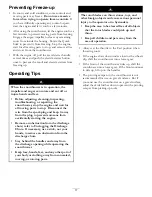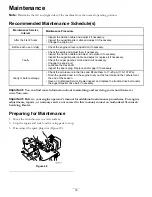
wear safety glasses or eye shields during operation or
while performing an adjustment or repair.
Operation
•
Do not put hands or feet near or under rotating parts.
Keep clear of the discharge opening at all times.
•
Exercise extreme caution when operating on or
crossing gravel drives, walks, or roads. Stay alert for
hidden hazards or traffic.
•
After striking a foreign object, stop the engine,
remove the wire from the spark-plug, thoroughly
inspect the snow thrower for any damage, and repair
the damage before restarting and operating the snow
thrower.
•
If the unit should start to vibrate abnormally, stop
the engine and check immediately for the cause.
Vibration is generally a warning of trouble.
•
Stop the engine whenever you leave the operating
position, before unclogging the collector/impeller
housing or discharge guide, and when making any
repairs, adjustments, or inspections.
•
When cleaning, repairing, or inspecting, make certain
the collector/impeller and all moving parts have
stopped. Disconnect the spark-plug wire, and keep
the wire away from the plug to prevent accidental
starting.
•
Do not run the engine indoors, except when starting
it and for moving the snow thrower in or out of the
building. Open the outside doors; exhaust fumes
are dangerous.
•
Do not clear snow across the face of slopes. Exercise
extreme caution when changing direction on slopes.
Do not attempt to clear steep slopes.
•
Never operate the snow thrower without proper
guards, plates, or other safety protective devices in
place.
•
Never operate the snow thrower near glass
enclosures, automobiles, window wells, drop-offs,
etc. without proper adjustment of the snow
discharge angle. Keep children and pets away.
•
Do not overload the machine capacity by attempting
to clear snow at too fast a rate.
•
Never operate the machine at high transport speeds
on slippery surfaces. Use care when reversing.
•
Never direct discharge at bystanders or allow anyone
in front of the unit.
•
Disengage power to the collector/impeller when
snow thrower is transported or not in use.
•
Use only attachments and accessories approved by
the manufacturer of snow thrower (such as wheel
weights, counterweights, cabs, etc.).
•
Never operate the snow thrower without good
visibility or light. Always be sure of your footing, and
keep a firm hold on the handles. Walk; never run.
•
Never operate the snow thrower without good
visibility or light.
•
Take all possible precautions when leaving the
machine unattended. Shift into neutral, set the
parking brake, stop the engine and remove the key.
Maintenance and Storage
•
Check all fasteners at frequent intervals for proper
tightness to be sure the equipment is in safe working
condition.
•
Never store the machine with fuel in the fuel tank
inside a building where ignition sources are present
such as hot water and space heaters, clothes dryers,
etc. Allow the engine to cool before storing in any
enclosure.
•
Always refer to owner’s guide instructions for
important details if the snow thrower is to be stored
for an extended period.
•
Maintain or replace safety and instructions labels,
as necessary.
•
Run the machine a few minutes after throwing snow
to prevent freeze-up of the collector/impeller.
Toro Snowthrower Safety
The following list contains safety information specific
to Toro products or other safety information that you
must know.
•
Rotating rotor blades can injure fingers or
hands.
Stay behind the handles and away from the
discharge opening while operating the snowthrower.
Keep your face, hands, feet, and any other part
of your body or clothing away from moving or
rotating parts.
•
Before adjusting, cleaning, repairing, and inspecting
the snowthrower, and before unclogging the
discharge chute,
stop the engine, remove the key,
and wait for all moving parts to stop.
•
Use the snow cleanout tool,
not your hands
, to
remove obstructions from the discharge chute.
•
Before
leaving the operating position, stop the
engine, remove the key, and wait for all moving parts
to stop.
3




































